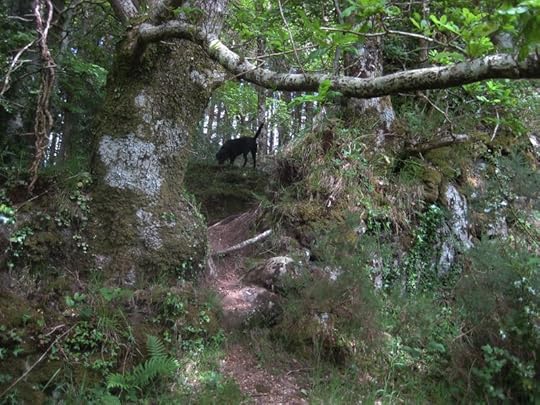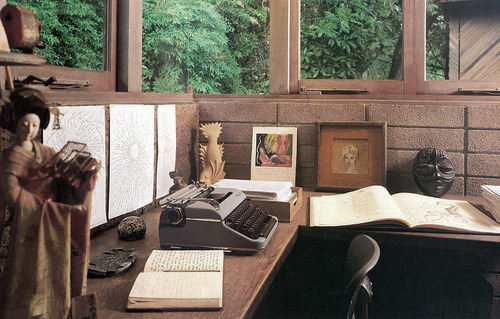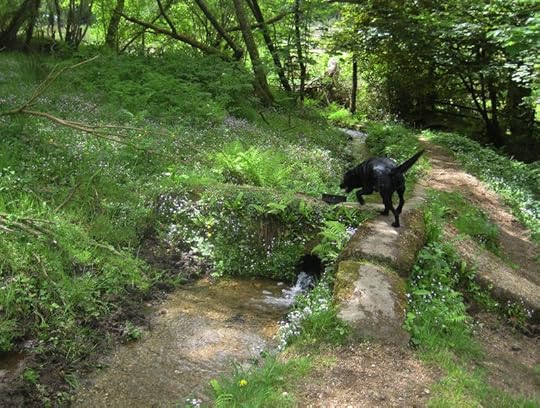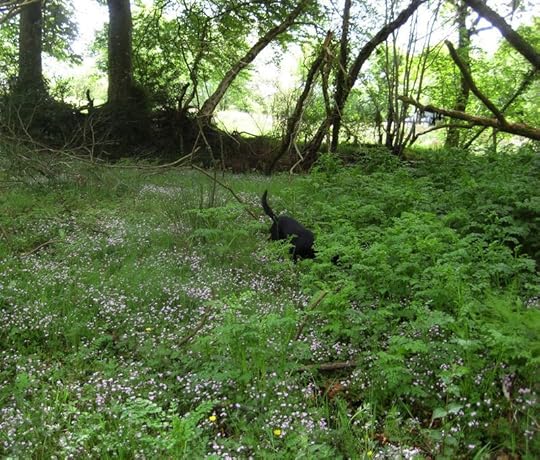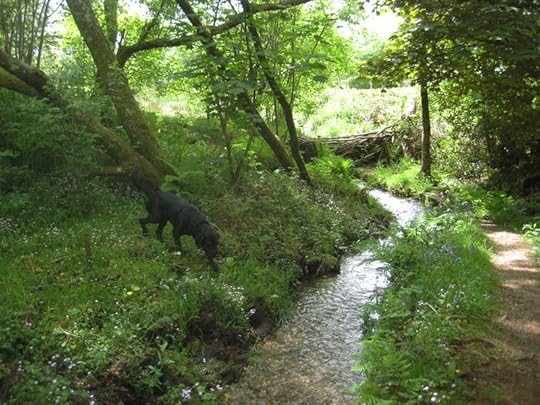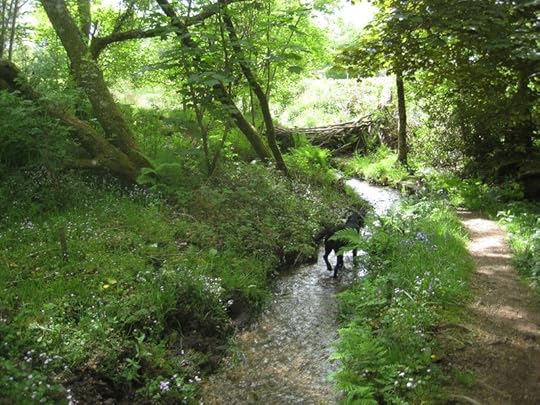Terri Windling's Blog, page 218
June 23, 2012
Inspired by the land
Today's recommendation: The Sisterhood of Ruralists, featuring the very beautiful art of Hannah Willow, Catherine Hyde, Tamsin Abott, and Jackie Morris. The name of the group riffs on the name of a an older group of artists, The Brotherhood of Ruralists (formed in the 1970s), which was in turn a riff on the 19th century's Pre-Raphaelite Brotherhood.
The image above, "The Space Between the Hare and the Fox," is a watercolour painting (with gold leaf) by Jackie Morris.
June 21, 2012
The courage to be bad
"Most people don't know what they want or feel. And for everyone, myself included, it's very difficult to say what you mean when what you mean is painful. The most difficult thing in the world is to reveal yourself, to express what you have to.... As an artist, I feel that we must try many things -- but above all, we must dare to fail. You must have the courage to be bad -- to be willing to risk everything to really express it all." - filmmaker John Cassavetes
"The first draft of anything is shit." - Ernest Hemingway
"A writer is a writer not because she writes well and easily, because she has amazing talent, because everything she does is golden. In my view, a writer is a writer because even when there is no hope, even when nothing you do shows any sign of promise, you keep writing anyway." - Junot Díaz
"Creativity is allowing yourself to make mistakes. Art is knowing which ones to keep." - comic strip artist Scott Adams
June 20, 2012
And I call it breathing
Here are the rules Henry Miller made for himself while working on Tropic of Cancer in Paris in the early 1930s (with the support of his writing colleague and lover, Anaïs Nin):
Work on one thing at a time until finished.
Start no more new books, add no more new material to "Black Spring."
Don't be nervous. Work calmly, joyously, recklessly on whatever is in hand.
Work according to Program and not according to mood. Stop at the appointed time!
When you can't create you can work.
Cement a little every day, rather than add new fertilizers.
Keep human! See people, go places, drink if you feel like it.
Don't be a draught-horse! Work with pleasure only.
Discard the Program when you feel like it—but go back to it next day. Concentrate. Narrow down. Exclude.
Forget the books you want to write. Think only of the book you are writing.
Write first and always. Painting, music, friends, cinema, all these come afterwards.
We write, said Anaïs in her famous Diaries, "to heighten our own awareness of life. We write to lure and enchant and console others. We write to serenade out lovers. We write to taste life twice, in the moment and in retrospection. We write, like Proust, to render all of it eternal, and to persuade ourselves that it is eternal. We write to be able to transcend our life, to reach beyond it. We write to teach ourselves to speak with others, to record the journey into the labyrinth. We write to expand our world when we feel strangled, or constricted, or lonely...When I don’t write, I feel my world shrinking. I feel I am in prison. I feel I lose my fire and my color. It should be a necessity, as the sea needs to heave, and I call it breathing."
I owe a huge debt to Anaïs Nin, because I fell into her diaries, essays, and collected letters in my Twenties and Thirties like a fish falling into water. She was, in some ways, a deeply flawed human being, and perhaps she makes a strange kind of hero for someone like me, committed to the ethical and spiritual dimensions of my craft as well as to the technical ones, but a hero and strong influence she remains nonetheless. I grew up at a time when feminism hadn't yet made much of a dent in university curriculums (even in a school as famously radical as Antioch), and in course after course in the Literature Department the texts I studied were by men, men, men. I also spent my late Teens and much of my Twenties in a relationship with an older, better educated man who was very much the dominant partner...and when I came out of that at age 27, I was determined to be my own woman, both in life and art -- but I didn't yet know who that woman was. I knew little about the work or lives of the women writers and artists who had come before me; I had no role models.
So I did what I always do when facing the unknown: I turned to books to guide me. I read every biography, autobiography, diary, or collection of letters by a woman in the arts I could lay my hands on. By happy chance, Anaïs's Diaries were among the first, and they completely captivated me -- for here was a woman asking the same questions that I was, trying to forge a creative life for herself as I was, and although she didn't always do it in ways that I entirely approved of (by which I mean the many lies and evasions she depended on to manage her dizzying number of relationships and affairs), still, I admired her determination to live life as fully, sensually, and intellectually as possible. Throughout her diaries and letters, passages like the one I've quoted here would stop me in my tracks, speaking across the decades from the cobbled streets of Paris to the cobbled streets of Boston (where I was living then).
Later, I would follow in her footsteps in Paris, searching out the places where she had lived, the cafes where she'd written or talked long into the night with writer and artist friends. But then, in Boston, it was simply her words I needed. The knowledge that another woman had asked these same questions, and found answers of her own. And I would too.
For a taste of Anaïs, go here to listen to her reading from her work (discussing writing with Henry Miller and Lawrence Durrell), recorded in 1966.
Images above: A Paris cafe, in Montparnasse, frequented by writers & artists in the '20s and '30s; Henry's typewriter in Paris; one of Henry's Paris notebooks; Anaïs in Paris; Anaïs and Henry in their later years; Anais with her husband Hugh Parker Guiler; and Anaïs's writing desk in California, in a house designed for her and her, um, second husband Rupert Pole (it's complicated) by Eric Lloyd Wright (grandson of Frank, and Rupert's half-brother).
June 19, 2012
The book of each of us
“There is not one big cosmic meaning for all; there is only the meaning we each give to our life, an individual meaning, an individual plot, like an individual novel, a book for each person.”
- Anais Nin
"I write to know what I think." - Joan Didion
"In a real sense, I am constantly writing autobiography, but I have to turn it into fiction in order to give it credibility." - Katherine Paterson
June 18, 2012
Mud and the muse
When you follow your dog...
...into a wildflower bog...
...there's no help for it, you're going to get wet, muddy, and stinky.
But you learn to be agile in the mud and muck...
...and to find new ways to get where you want to go...
...and you discover things that you would have otherwise missed...
...like this lovely water garden at the end of the leat.
Following the Muse is like that too. Sometimes, in the middle of a story or a painting, you find yourself wallowing through the sticky, boggy bits and you just have to keep on going, no matter where it leads.
But I'm ready for the journey. I'm wearing sturdy boots, and I'm prepared to get muddy. So let's go.
A cup of tea with Brian and Wendy Froud...
Part I of the "Around the Table" chat with Brian & Wendy Froud is now up on the John Barleycorn blog...which includes a sneak peak at a page-spread from their forthcoming book, Trolls. Part II (with more art from the new book) will go on-line next Monday. Enjoy!
"I feel that what you should illustrate is the space between the words. It's the betweenness, the otherness, that gives depth and dimension." - Brian Froud
June 17, 2012
Tunes for a Monday Morning
Today's tunes are...
Above: "Willow Tree" from Unkle Vanya, a terrific new alt-folk band from central Scotland. The video, according to the band, was shot in a mystery wood in deepest Renfrewshire.
Below: "Otmoor Forever," performed by members of Andy Letcher's wonderful band, Telling the Bees -- an Oxford-based group playing "darkly crafted folk." (I highly recommend the band's two CDs.) The song is based on a true story from the 1800s.
June 15, 2012
The Year of the Roses
The Mythic Imagination Institute's online magazine is up and running again, and the new version is gorgeous. This year's theme is "The Year of the Roses," and the first issue in the series is focused on fairy tales. You'll find a link to the magazine on the Mythic Imagination website.
(Matthew & the Atlas' song and video, "Within the Rose," which has been in heavy rotation on my stereo lately, would make the perfect soundtrack for this issue.)
Also, as long as I'm recommending links this morning, N.K. Jemison has a good post about writing fantasy magic here, which (as Ellen Kushner so eloquently describes it) stands up for the numinous in fantasy literature. Bravo for that.
And a video recommendation (via Ari Berk): automata artist Thomas Kunz' "Une Saison En Enfer."
The little "Rosebud" picture above is from an old sketchbook of mine.
June 14, 2012
The best time to begin
The best time to begin is now.
“One of the things I know about writing is this: spend it all, shoot it, play it, lose it, all, right away, every time. Do not hoard what seems good for a later place in the book or for another book; give it, give it all, give it now. The impulse to save something good for a better place later is the signal to spend it now. Something more will arise for later, something better.” - Annie Dillard
But, but, but....
No, no "buts"...now is the time. My time. Your time. Our time. The world's time. When life circumstances conspire to hold us back and rob the hours from our days, then the hell with it, let's begin anyway...if not always on the canvas or the page then in our thoughts, our dreams, in the quiet moments of washing the dishes and falling to sleep. Begin in imagination. Reality will follow, just as soon as it can. As above, so below; as below, so above.
As Hillel the Elder famously said: "If I am not for myself, who will be? If I am only for myself, who am I? If not now, when?"
 Pictures above: At the edge of Elizabeth-Jane Baldry's Pigwiggen Wood, four Faery Godmothers lead the way.
Pictures above: At the edge of Elizabeth-Jane Baldry's Pigwiggen Wood, four Faery Godmothers lead the way.
June 13, 2012
What one writes
"The pages are still blank, but there is a miraculous feeling of the words being there, written in invisible ink and clamoring to become visible." - Vladimir Nabakov
"If there's a book you really want to read, but it hasn't been written yet, then you must write
it." - Toni Morrison
The pictures here are Golden Age fairy tale illustrations by H.J. Ford (1860-1941) and John D. Batten (1860-1932). I could tell you which fairy tales they are from...but I'd rather leave you to imagine stories of your own. Those are the stories I want to read. Those are the stories I want to write.
Terri Windling's Blog
- Terri Windling's profile
- 707 followers




